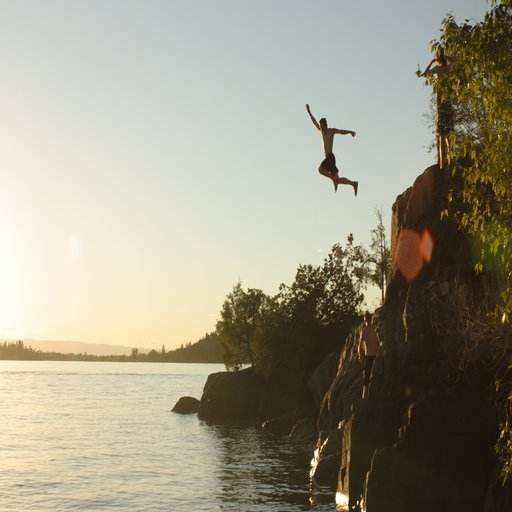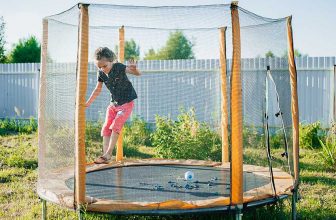Last Updated on May 28, 2022
Trampolines are not only a toy for entertainment but they also have wide applications in today’s life. When it’s time for choosing a trampoline for a specific task, most people get confused about selecting the right one from different types of trampolines. To provide you with the best solution in this regard, we have come up with today’s article.
Of the wide variety of trampolines, only some of them are perfect for fulfilling your tasks. In most cases, the function of a trampoline, as well as its price, largely depends upon its shape, size, and a few more things. Let’s learn about various types of trampolines!
18 Different Types of Trampolines And Their Uses

The basic function of a trampoline is to provide bounce and make fun. But, one trampoline prevails over another type according to its functionality. The overall construction of trampolines is almost the same. However, all of them are not appropriate for all purposes.
Maybe you need a trampoline for backyard, in-ground, fitness, or outdoor uses. Sometimes, you might choose according to springs quality, shapes, enclosure net, and many other factors. So, trampolines can be chosen from different viewpoints. In the same way, they are classified into different categories.
Let’s explore different trampolines types!
Trampolines Based on Their Shapes
There are different shapes of trampolines developed over the years of tramp history. The common shapes of trampolines are rounds, rectangles, ovals, squares, and polygons. If you want to know the dissimilarities between octagonal vs rectangle vs round trampolines, then the next topic is for you.
Round Trampolines
Round trampolines are the most widely used trampolines for recreational activity. These trampolines are mostly suitable for kids but adults can use them also. The trampolines will guide you toward the center, because of their design. So, it declines the risk of falling outside and occurring accidents. But the edges are not perfect for jumping like the quality JumpKing trampolines.
Commonly they come in different sizes from 8 to 25 ft. With the increase in sizes, their costs rise. These tramps are safe, but due to their low bouncing quality pro acrobats don’t use them frequently.
Rectangular Trampolines
Rectangular trampolines are professional-grade trampolines and allow more bouncing than the round types. Actually, the gymnasts prefer these trampolines most but they can be used for daily fun for kids and adults too. Considering space, these types need smaller areas than the round trampolines. And, they deliver even bounce throughout the surface.
Children and newbies need to be cautious using rectangular trampolines, as there are more chances of being injured. It is recommended not to jump very close to the edges to avoid unexpected injury.
Oval Trampolines
This is almost similar to circular trampolines. They have larger jumping areas due to their shape. Actually, oval trampolines are a combination of rectangular and round types. So you will get extra advantages from here. Like the round trampolines, these tramps tend to pull acrobats to their center at the same time they deliver high bouncing like a rectangular tramp.
If you have a large backyard, then the oval trampoline is a good choice for you. You need to pay attention to assembling and disassembling these trampolines. Also, you need to clean these trampolines after some days to increase their life span.
Square Trampolines
The square trampolines come with the combined benefits of round and rectangle-shaped trampolines. It is safe as a round model as well as it can be used as gymnast tramps like a rectangular type. However, these models are more cost-efficient than rectangular-shaped trampolines.
These jumping toys can be used as gymnast trampolines at home or outdoors. It’s a good option if you have a tight budget.
Hexagonal, Octagonal or Polygonal Trampolines
You will find some trampoline that comes with polygonal shapes such as hexagon or octagon. These types are like round trampolines and provide high performance overall. If you need a trampoline for several kids’ plays, then this is certainly a good option.
Most of the polygon tramps are expensive products. They are not very popular as round or rectangular shapes. You need more space to set up these trampolines. Their rebounding varies with their sizes.
Purposes Based Types of Trampolines
Trampolines are used for different purposes such as recreation, fitness, and competition.
Recreational Trampolines
Probably, you want to entertain and make healthy your children. Then the trampoline is a good option. Setting a trampoline in your backyard or in-ground, surely you can easily make pleased your kids. They include both the in-ground and water trampolines. Besides the kids, adults can also have fun with trampolines. There are plenty of adult-grade trampolines to choose from.
These toys are safer and cost-efficient than competition trampolines. Most recreational trampolines come in round shapes.
Competition Trampolines
The competition trampolines are high-performing units and are used for professional purposes. They provide high bounce equals lots of energy burning. Mainly, these trampolines are used by skilled trampoline users such as gymnasts and Olympic sports performers.
Olympic trampolines are constructed from durable materials for higher bouncing. For their great performance, they are more expensive than regular trampolines. If you are not a pro gymnast, please don’t use them.
Fitness Rebounders or Mini Trampolines
Rebounders or mini-trampolines are small bouncy trampolines. They are mostly used for elevating heart rate and fitness purposes without doing very hard work. These compact trampolines can be set in a corner of your room and easily hidden away in a closet. If you don’t have a large backyard, then you can choose this and taste the trampolining. This trampoline is a good option instead of jogging.
Nowadays, they come with a fitness tracker monitor that shows your total jumps, workout times, jumps per minute, and even the calories that you have burnt during exercise.
Springs Based and Spring Free Trampolines
Generally, most of the trampolines that we see are spring-based. But there are some trampolines that don’t use springs. So, what is the difference between spring vs spring-free trampolines?
Trampolines with Springs
Spring-based trampolines are widely used trampolines. Sometimes they have mentioned traditional trampolines. With the increase of springs number, their bounces go upward. Usually, springs’ length higher than 7-inches provides high bouncing.
When purchasing these tramps, you should check whether the springs are fully covered with a safety pad or not. A safety pad cover is an essential thing for spring-based trampolines.
Springless Trampolines
There are some trampolines that come with a spring-free structure. In these tramps, there are fiberglass rods to support the jumping mat. They are a safer option compared to spring-based traditional trampolines like the skywalker ones. These are definitely a good choice, if you want a hurtles bouncer. Some of them can be used in water as well as on the ground.
Inflatable or Water Trampolines and bouncer
Water trampolines have inflatable tubes instead of springs. These special trampolines have water floating ability and sometimes they are called bouncers. These trampolines are lightweight compared to ground tramps. With an air blower, you can easily expand the tubes and make them useable within a few minutes.
Jumping on an inflatable water trampoline gives you a wonderful experience. Besides bouncing in the tramp, you can swim in the water and get refreshed within a few moments. Like ground trampolines, there is no need for an enclosure net.
There are some additional attachments with the tramps such as slides, easy boarding, etc. You need to anchor first, before using this trampoline. An important thing about the aquatic trampoline is that you need to set your water trampoline at least 8 feet water height lake.
Bungee Trampolines
Probably you have noticed bungee trampolines in fairs, summer-winter camps, or gathering places. These are used for recreation and everyone can have fun with them. These tramps use plenty of bungee cords instead of springs that actually create bouncing.
While jumping on bungee trampolines, the acrobats must put on a harness and then attach to the structure. These trampolines deliver 10 to 26 feet of outstanding bouncing.
Size Based Trampolines
Variable-sized trampolines are needed for different uses, acrobats’ ages, and weights. Here are short descriptions of different trampolines sizes according to their skills.
Large Trampolines
Usually, gymnasts need a higher bounce and a big measured trampoline. According to their choices, the sizes may vary. For round tramp users, it is recommended to take over a 14-feet trampoline. If you’re a rectangular jumper, then 10×17 feet or large sizes trampolines are suggested for you. That can hold a lot of weight.
Medium and Small Trampolines
Kids and teenagers need a medium or small-sized trampoline. Besides bounce, the safety issue is also important for them. Their standard sizes are 7×10, 8×12, and 9×14 feet trampolines. For round trampolines, the diameter should not exceed 12 feet.
Pre-school Trampolines
Most trampolines manufacturers produce mini-sized trampolines for toddlers. They have a lower carrying capacity and bouncing compared to the larger ones. These lower bouncing trampolines keep safe whilst giving fun.
Trampolines Based on Enclosure Styles
Trampolines have different styles of enclosing systems. They might come with the surrounding net, open, or handle options.
Trampolines with Enclosure
You will find different trampolines that come with the enclosure net. This netting prevents acrobats from falling to the ground and keeps them safe. Usually, the enclosure net is made of mesh materials so that you can keep watching your kids sitting outside. The enclosure net height is also important. Most of the enclosures have at least 6 feet of net height.
Exposed In-Ground Trampolines
You will find some trampolines that have no dedicated surrounded net. The modern in-ground types of trampolines are exposed enclosures and they are safe fully. Nowadays, this is considered one of the greatest trampolines for kids.
These types are also found in competition, bungee, and water trampolines. If the frame of the trampoline is very high, then you have to be cautious about using these tramps.
Exposed Trampolines with Handles
There are several mini trampolines or rebounders that come with single or double handlebars. By adjusting the handle heights, you can use your trampolines for gym tasks. Padded handles are a comfortable option in this regard.
Conclusion
From the above discussion, hope you have known the different types of trampolines and their uses. This will be helpful for you when you go buy your next trampoline. Again we are reminding you that rectangular tramps are for higher bounce and circular types are safer options.
So, choose them according to your needs and take good care of your trampoline. Have fun!

Noah is a family guy who loves to hang out with friends and family whenever he finds some time and space. Enjoying a trampoline time is one of his favorites form of recreation. Life is beautiful for Noah!






[…] True Trampoline describes the oval trampoline as the closest to a round trampoline, except for being stretched out into an oval shape. The only difference is the elongated shape. The advantage of an oval trampoline is that they’re more fun for acrobats to start at the center and perform flips and summersaults. The additional length makes it safer to perform a variety of fun maneuvers for those who are athletic such as gymnasts and tumblers. These trampolines deliver high bouncing potential, similar to a rectangular trampoline. They’re used in a backyard during warm and cool months of the year. You can buy oval trampolines in both medium and large models as the larger ones accommodate more jumpers when used for recreational purposes. […]
[…] Vero trampolino descrive il trampolino ovale è il più vicino a un trampolino rotondo, tranne per essere allungato in una forma ovale. L’unica differenza è la forma allungata. Il vantaggio di un trampolino ovale è che è più divertente per gli acrobati iniziare dal centro ed eseguire salti mortali e salti d’estate. La lunghezza aggiuntiva rende più sicuro eseguire una varietà di manovre divertenti per coloro che sono atletici come ginnasti e tumbler. Questi trampolini offrono un elevato potenziale di rimbalzo, simile a un trampolino rettangolare. Sono usati in un cortile durante i mesi caldi e freddi dell’anno. Puoi acquistare trampolini ovali sia nei modelli medi che grandi poiché quelli più grandi ospitano più maglioni quando vengono utilizzati per scopi ricreativi. […]